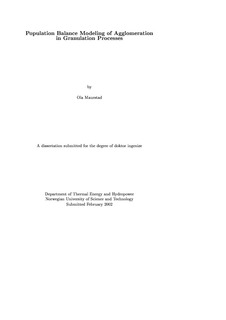| dc.contributor.author | Maurstad, Ola | nb_NO |
| dc.date.accessioned | 2014-12-19T11:24:28Z | |
| dc.date.available | 2014-12-19T11:24:28Z | |
| dc.date.created | 2002-05-16 | nb_NO |
| dc.date.issued | 2002 | nb_NO |
| dc.identifier | 121906 | nb_NO |
| dc.identifier.isbn | 82-471-5432-3 | nb_NO |
| dc.identifier.uri | http://hdl.handle.net/11250/231143 | |
| dc.description.abstract | Agglomeration (the sticking together of particles) is often the major growth mechanism in granulation processes. The population balance equation (PBE) is a mathematical framework that is often applied to systems to describe how the particle size distribution changes as a function of time. Different kinetic terms are included in the PBE to describe the different particle growth mechanisms. In this work, a new kinetic model framework is proposed for the growth mechanism binary agglomeration. Binary agglomeration means that only two particles are involved in an agglomeration event. The generality of the new model framework is an advantage over the previous coalescence kernel framework. It is shown that an existing coalescence kernel model can be expressed by means of the new framework.
The new model framework is then adapted to the special case of fluidized bed granulation (FBG) by proposing/choosing expressions for the three submodels in the model framework. An advantage of the new FBG model is that a maximum number of agglomeration events per unit time can be estimated. This means that the model is one step closer to being used predictively. At the moment, no population balance models can predict granulation processes where agglomeration is the dominant growth mechanism. It is shown that both the new FBG model and an existing model could fit experimental data well, however, the new model reflects the situation that the presence of surface liquid is rate limiting for the agglomeratio process.
Experiments in a laboratory batch fluidized bed granulator were carried out. Samples of the particle size distribution were taken at intervals during an experiment. These data were used to fit the model parameters of the FBG model. The dissertation includes a discussion of the effect of certain operating conditions such as bed temperature and liquid spray rate on a model parameter. | nb_NO |
| dc.language | eng | nb_NO |
| dc.publisher | Fakultet for ingeniørvitenskap og teknologi | nb_NO |
| dc.relation.ispartofseries | Dr. ingeniøravhandling, 0809-103X; 2002:38 | nb_NO |
| dc.title | Population Balance Modeling of Agglomeration in Granulation Processes | nb_NO |
| dc.type | Doctoral thesis | nb_NO |
| dc.source.pagenumber | 93 | nb_NO |
| dc.contributor.department | Norges teknisk-naturvitenskapelige universitet, Fakultet for ingeniørvitenskap og teknologi | nb_NO |
| dc.description.degree | dr.ing. | nb_NO |
| dc.description.degree | dr.ing. | en_GB |
